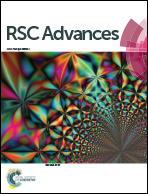Cell membrane permeable fluorescent perylene bisimide derivatives for cell lysosome imaging†
Abstract
We have developed acid activated fluorescent probes based on amphiphilic perylene bisimide with morpholine groups on the bay (Lyso-APBI). Incorporating one morpholine group, Lyso-APBI-1 showed an acid activated fluorescence increase of 70-fold upon pH values lowering from 8.0 to 4.0. Lyso-APBI-2, with two morpholine groups on the bay of PBI, had a red-shifted emission and a 190-fold fluorescence enhancement within same pH variation range. These Lyso-APBI probes have excellent membrane permeability, low cytotoxicity, and can rapidly accumulate and specifically activate in cell lysosomes. The double morpholine moieties make Lyso-APBI probes have higher acid activation ratio and better cell lysosome specificity. Moreover, long-time cell imaging proved the relatively high photostability of Lyso-APBI probes in a harsh physiological environment.


 Please wait while we load your content...
Please wait while we load your content...